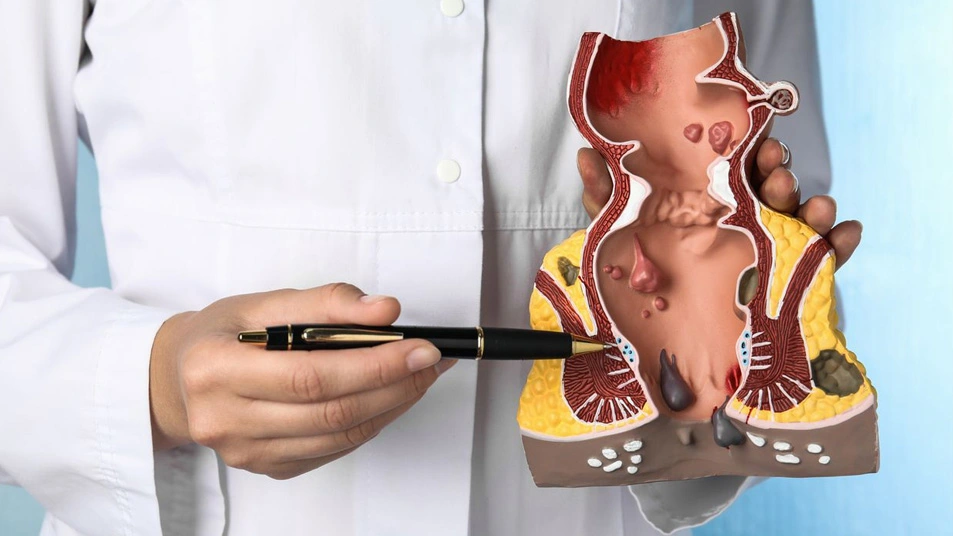
Anal Fistula Treatment, Fistula Specialist in Konkan
An irregular tube or connection that joins two organs or vessels that don't normally link is called a fistula. They can appear anywhere, including in the space between the rectum and the vagina and the gut. The area surrounding the anus is where fistulas most frequently occur.
An abscess, or diseased cavity in the anus, is connected to an opening on the skin around the anus by a tiny tunnel called an anal fistula. The external orifice that allows the body to evacuate waste is called the anus. Numerous tiny glands that produce mucus are located just inside the anus. These glands occasionally clog and can get infected, which can result in an abscess. Of these abscesses, almost 50% might become fistulas.
Causes of Fistula :
Fistulas can develop anywhere in your body, from one organ to another or from one organ to a skin incision. They often appear after an accident or illness causes your tissues to become inflamed for an extended period of time. Persistent infection and inflammation, particularly when pus has to drain, might eventually erode into the surrounding tissues. This may open a passageway between the surrounding tissues and the wound.
Anal gland infection is typically the site of a perianal abscess, which is the most frequent cause of anal fistula. A pocket of pus that forms at the site of an infection is called an abscess. The pus must escape, and it could make a pathway for itself to do so. Occasionally, a medical professional makes a drainage canal.
Uncommon causes of anal fistulas include :
Inflammatory bowel diseases, such as Crohn’s disease.
Tuberculosis affecting your anus.
A traumatic injury or previous surgery in your anus.
Radiation therapy for cancer in your pelvic region.
Actinomycosis, a rare bacterial infection that causes abscesses, sometimes in your perianal region.
Hidradenitis suppurativa, a chronic inflammatory skin disease that produces abscesses in your sweat glands, occasionally in your perianal region.
Symptoms Of Fistulas :
The most common anal fistula symptoms are :
Anal discomfort that is frequently sharp and throbbing. When you cough, defecate, or sit, you can feel it more. You might be able to touch your butt.
Inflammation inside or around your anus that manifests as swelling and redness. These indicate a live cellulitis infection beneath the skin.
A fluid outflow from the vicinity of your anus. It might consist of blood (rectal hemorrhage), pus, or feces. It may be smelling.
Less common symptoms include:
Fever.
Pain while urination.
Difficulty in holding the feces inside.
Using a mirror to view the fistula may or may not be possible.
Diagnosis of Fistula :
The majority of anal fistulas are detectable by medical professionals by physical examination, yet occasionally the external hole closes. Additionally, the physician will search for the fistula's internal entrance within patients anus. This section may need to be sedated. The healthcare professional might have to examine the patient under anesthesia in the operating room if touching or opening your anus causes excessive pain.
The healthcare professional may use a lighted scope, such as an anoscope or proctoscope (a larger scope that can view the rectum), to locate the internal cause of the fistula. In order to identify the infection at the fistula's origin, medical professionals occasionally inject hydrogen peroxide into the external aperture. The peroxide and the infection will interact.
Tests for Fistula :
The healthcare professional may find it necessary to do radiological tests in order to track the course of patients fistula. The physician must be aware of its course and then can decide how to treat the fistula. Patients fistula will be categorized based on its course.
MRI (magnetic resonance imaging). MRI is a high-detail, non-invasive imaging exam which can assist medical professionals in charting the tunnel's course and determining how it affects your muscles and other organs.
Endoscopic ultrasound. An endoscopic ultrasound uses a small, illuminated camera and a tiny ultrasonic probe to create images within your abdomen instead of an MRI, which creates images comparable to what it sees.
Fistulography. The healthcare professional will take an X-ray of your fistula after injecting dye into it, which is known as a fistulogram. The fistula's route will be highlighted by the dye.
Types of Fistula :
Anal fistulas are categorized by medical professionals based on how close they are to the anal sphincter muscles. The bowel motions of a patient are controlled by these muscles, therefore it's critical to maintain their health. Depending on where it is located, your provider may refer to your anal fistula by a particular term, like :
1. Anal Fistula
Swelling and Pain surrounding the anus
Skin irritation surrounding the anus
Pus or blood leaking from an orifice close to the anus
Painful bowel motions
Fever (if infected)
2. Enterocutaneous Fistula (between the intestine and skin)
Abnormal intestinal contents passing through the skin
Prolonged, perhaps odorous skin drainage
Abdominal discomfort
Fever and chills (if infected)
Dehydration and Nutritional deficiencies
3. Rectovaginal Fistula (between the rectum and vagina)
Gas or stool coming out of the vagina
Recurrent infections in the vagina
Odorous vaginal discharge
Pain during sexual activity
Infections of the urinary tract
4. Vesicovaginal Fistula (between the bladder and vagina)
Urine leaking into the vagina frequently
Recurrent infections in the urinary tract
Itching in the vagina
Putrid-smelling exudate
5. Gastrointestinal Fistula (between parts of the digestive system)
Tenderness and soreness in the abdomen
Diarrhea
Inadequate nutrition absorption
Loss of Weight
Fever (if contaminated)
6. Arteriovenous Fistula (abnormal connection between an artery and a vein)
Swelling in the limb that is injured
A throbbing lump beneath the skin
Tenderness or pain at the location
Diminished circulation resulting in chilled extremities
Heart failure (in extreme situations)
7. Obstetric Fistula (due to childbirth complications)
Constant feces or urine leaks via the vagina.
Recurrent infections
Emotional and Social distress
Genital sores and infections of the skin
General Symptoms (if infected)
Fever
Chills
Malaise
Redness and warmth around the fistula site
The Medical practitioner manages the sort of anal fistula a patient has. If a large portion of the sphincter muscles are involved, the course of therapy may need to be changed. When surgeons repair your anal fistula, they must take care to avoid hurting these muscles.
Treatment for Anal Fistula :
Surgery is usually required to repair anal fistulas. After spontaneous healing, the fistula often reopens due to recurrent infections and abscesses. On the other hand, if your fistula is uninfected and the result of inflammatory bowel illness, it may occasionally heal with medical intervention. In order to treat these fistulas, your doctor may first attempt immunomodulator therapy, such as infliximab.
Anal fistula surgery :
Depending on how simple or complicated the fistula is, anal fistula surgery can be either easy or complex. Simple, intersphincteric fistulas that only involve a short bit of muscle are the most prevalent type of anal fistulas. Treating them with a single procedure is safe. Stepwise surgery may be required for more difficult fistulas.
Simple fistulas : The anal fistula is regarded as uncomplicated if it just includes a little amount of muscle and has no branches. Fistulotomy is the surgical procedure used to treat a straightforward fistula. About 95% of patients find that this one-step operation is the most straightforward and successful technique to cure an anal fistula.
Fistulotomy : The fistula's ceiling will be sliced through by the colorectal surgeon to allow it to fill in from the bottom up. They may also take out tissue that is infected. A tiny amount of muscle may be damaged when cutting through the roof, but that's okay. If there are too many muscle cuts, the patients bowel control may suffer.
Complex fistulas : The fistula is classified as complicated if there are branches having a large amount of muscle involved, or a patient has underlying medical issues that increase risk of surgical complications. Multiple procedures may be necessary to repair complex fistulas. One or more of these methods may be employed by the colorectal surgeon:
Seton drain. A Seton is a kind of surgical thread that needs to be removed as it doesn't absorb over time. The surgeon loops the seton through the patients Fistula to keep it open for long to drain out all of the effluent. In addition, a seton can gradually sever the fistula tract, enabling the tissue to mend as it penetrates the muscle. Finally, it aids in the localized scarring of the tissue to prevent the incision from rupturing later. Afterwards, your surgeon could perform a fistulotomy or similar treatment to remove the drain and seal the fistula. The surgeon may decide to keep the seton drain in place forever if a persistent ailment, such as inflammatory bowel disease, is the cause of the fistula.
Endorectal advancement flap. This treatment preserves the integrity of your sphincter muscles by avoiding cutting into the fistula's ceiling, Rather, the contaminated tissue surrounding the internal hole of anal fistula is excised by the surgeon. Subsequently, a flap of healthy tissue from the interior of the rectum is pulled down to conceal this hole. After draining from the external hole, the fistula should start to mend from the inside out. Although this operation is thought to be roughly 70% successful, the infection and fistula might nevertheless recur in certain individuals. When cutting the flap, there is still a chance (about 30%) of hurting the sphincter muscle.
LIFT procedure. LIFT "Ligation of Intersphincteric Fistula Tract" refers to the closure (ligation), generally with sutures, of the intersphincteric fistula, which runs between the two sphincter muscles. Next, the surgeon may either scrape away the contaminated tissue within or remove the entire fistula tract from this area. Usually, this process comes after a seton drain surgery. It doesn't run the danger of damaging sphincter muscles; however it is marginally less effective than fistulotomy (75%).
Precautions after Anal Fistula surgery :
Although some patients may need to return for further surgery, anal fistula operations are often performed as outpatient procedures, allowing patient to return home the same day. The patient will receive guidelines for self-care as well as prescription painkillers to take home. These might consist of :
Water and fiber supplements. The doctor may recommend fiber supplements to avoid constipation as a side effect of painkillers. It's crucial to take these along with plenty of water.
Sitz bath. At least once a day, soaking the anus in a warm in Sitz bathtub will assist to relieve discomfort and hasten recovery.
Wound management. In order to keep the wound clean, the patient need to use dressings to collect drainage and change them frequently.
Prognosis of Anal Fistula
Whether the Anal Fistula is simple or complicated will determine the further treatment. This establishes the length of the rehabilitation and treatment plan. Recuperating from one or more procedures may take three to six weeks. After surgery, some fistulas recur, particularly if they were caused by a persistent disease or had several branches. Anal fistulas can occur several times in IBD patients.
Consult a doctor whenever the patient face anal discomfort. Significantly painful anorectal disorders may be dangerous. Never presume that it will go away on its own. Although they are more prevalent and well-known, hemorrhoids often don't hurt all that much. See a doctor if a general practitioner (primary care) diagnoses you with a hemorrhoid yet the pain persists.
